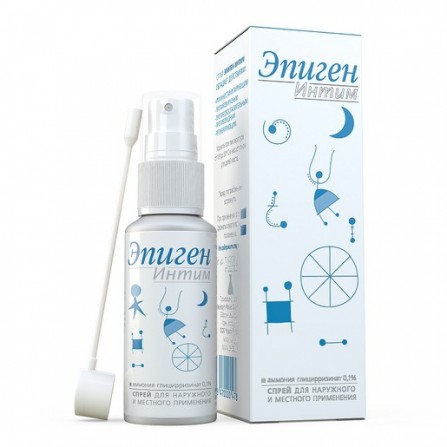Epigen intimate aerosol 15ml
Condition: New product
998 Items
Rating:
Be the first to write a review!

More info
Active ingredients
Ammonium Glycyrrhizinate
Release form
Spray
Composition
In 100 ml: Glycyrrhizic acid (glycyrrhizinic acid) 100 mg. Excipients: malic acid - 3 g, fumaric acid - 2 g, ascorbic acid - 0.3 g, folic acid - 0.08 g, propylene glycol - 50 g, tween 80 (polysorbate 80) - 0.9 g, purified water - up to 100 ml.
Pharmacological effect
The active ingredient of Epigen Intim is activated glycyrrhizinic acid, obtained by extraction from plant raw materials (licorice root). Activated glycyrrhizinic acid has a complex effect, including immunostimulating, antiviral, anti-inflammatory, antipruritic and regenerating. an increase in the number and activity of T-lymphocytes, a decrease in the concentration IgG and increasing concentrations of IgA and IgM. Activated glycyrrhizic acid has an antiviral effect on different types of DNA and RNA viruses in vitro and in vivo (Varicella zoster; herpes simplex virus types 1 and 2; CMV, various types of human papilloma virus, including oncogenic). Activated glycyrrhizinic acid interrupts viral replication in the early stages, causing the virion to exit the capsid, thereby preventing its penetration into the cells. Activated glycyrrhizic acid inactivates these viruses in non-toxic concentrations for normally functioning cells. Mutant virus strains resistant to acyclovir and iodouridine are also highly sensitive to glycyrrhizic acid, as are non-mutant strains. The anti-inflammatory activity of activated glycyrrhizic acid is combined with a stimulating effect on humoral and cellular immunity factors. Activated glycyrrhizic acid significantly inhibits the release of kinins and the synthesis of PG by connective tissue cells in the area of inflammation. The regenerating effect is due to the improvement of the reparation of the skin and mucous membranes.
Pharmacokinetics
When applied topically and locally, activated glycyrrhizic acid is deposited in the lesions. Systemic absorption is slow. The drug is found in the blood in trace amounts.
Indications
Treatment of genital infections caused by the Herpes simplex type 2 virus (both in acute primary and in relapsing course); treatment of skin infections caused by the virus Varicella zoster (as part of combination therapy); treatment of infections of the skin and mucous membranes caused by the human papilloma virus; treatment of nonspecific vaginitis, colpitis. Prevention of common sexually transmitted viral infections.
Contraindications
Hypersensitivity to glycyrrhizic acid.
Precautionary measures
During the period of treatment, it is not recommended to use interferon synthesis inducers.
Use during pregnancy and lactation
Application during pregnancy and lactation is possible according to absolute indications. In experimental studies, the embryotoxic and teratogenic action of glycyrrhizic acid has not been established.
Dosage and administration
Outer, intravaginal, intraurethral. Shake the can before use. At application to hold a cylinder in vertical position. When applied externally, the drug is applied to the entire affected skin surface from a distance of 4–5 cm 1–2 by pressing the valve, which is the optimal therapeutic dose. For intravaginal use of the drug, a special spray nozzle is attached. Remove the valve from the spray bottle and put on the nozzle valve. Then insert the nozzle into the vagina and make the injection by 1–2 presses of the nozzle, which is the optimal therapeutic dose. For herpesvirus infection type 1, herpes zoster is recommended to be used 6 times a day, on the lesion, for 5 days. In case of herpes infection type 2 (genital herpes), CMV infection is recommended to be used 5 times a day for 14 days outwardly and intravaginally. To prevent recurrence of genital herpes and CMV infection, it is recommended to use the drug outwardly and intravaginally from day 18-20. the menstrual cycle before the end of menstruation, 2 times a day, morning and evening. As a prophylactic antiviral agent, the drug is recommended to be used before and after sexual intercourse.
Side effects
Seldom: allergic reactions.
Interaction with other drugs
With simultaneous use of glycyrrhizic acid with other antiviral drugs (acyclovir, iodouridine, interferon), potentiation of antiviral action is noted.
special instructions
When treating skin infections caused by the Varicella zoster virus, external use of glycyrrhizic acid should be combined with the ingestion of specific antiviral drugs. If there is evidence of irritation of the skin or mucous membranes, treatment should be stopped.





